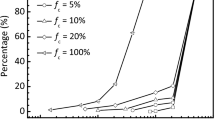Abstract
In this paper, an experimental study concerning the relevance of the initial stress state and the inclination of principal effective stress to vertical (α) on the behavior of sand is presented. The study was carried out using the dry air pluviated Firoozkuh sand in a hollow cylinder apparatus. Most of the specimens were consolidated subjected to the anisotropic initial stress state, which is made by maintaining the principal stress ratio (i.e., R c ) and the inclination of initial principal stress (i.e., R c ) constant during the consolidation phase. Shear loading was carried out in the drained condition while the value of α and intermediate principal stress ratio (i.e., b) were held constant. Sands subjected to the anisotropic vertical initial stress (R c = 2, α c = 0) are found to be highly influenced by α due to initial induced anisotropy in addition to inherent anisotropy. The anisotropic response of medium dense sands is observed to be strongly dependent on α c . The effect of soil anisotropy, specifically initial induced anisotropy, on the shear modulus is more noticeable than the shear strength. The initial induced anisotropy due to the initial stress state of medium dense sand may have a significant influence on the deformation of geotechnical structures such as shallow foundations, so that its neglecting may lead to unsafe designs.
Similar content being viewed by others
References
Arthur, J. R. F., Bekenstein, S., Geramine, J. T., and Ladd, C. C. (1981). “Stress path tests with controlled rotation of principal stress drictions.” Symp. on Laboratory Shear Strength of Soils, ASTM STP 740, pp. 516–540.
Aziz, M., Towhata, I., Khan, A. H., and Saleem M. A. (2013). “Behavior of granular soils under dry and saturated conditions in cyclic torsional shear tests.” Pak. J. Eng. & Appl. Sci., Vol. 12. pp. 1–8.
Bahadori, H., Ghalandarzadeh, A., and Towhata, I. (2008). “Effect of non-plastic silt on anisotropic behavior of sand.” Soil and Foundations, Vol 48, No. 4, pp. 531–545.
Cai, Y. (2010). An experimental study of non-coaxial soil behaviour using hollow cylinder testing, PhD Thesis, University of Nottingham.
Cambu, B. and Lanier, J. (1989). “Induced anisotropy in cohesionless soil: experiments and modelling.” Computers and Geotechnics, pp. 291–311.
Casagrande, A. and Carillo, N. (1944). “Shear failure of anisotropic materials.” J. Boston Society of Civil Engineering, Vol. 31, No. 4, pp. 122–135.
Doanh, T., Dubujet, Ph., and Protiére, X. (2012). “On the undrained strain-induced anisotropy of loose sand.” Acta Geotechnica, DOI: 10.1007/s11440-012-0201-8.
Foundoukos, M. (2005). Investigation of soil anisotropy using a hollow cylinder apparatus and numerical analysis, PhD Thesis, Imperial College London.
Hight, D. W., Genes, A., and Symes, M. J. (1983). “The development of new hollow cylinder apparatus for investigating the effects of principal stress rotation in soils.” Geotechnique, Vol. 33, No. 4, pp. 355–383.
Kumruzzaman, M. and Yin, J. H. (2010). “Influence of principle stress direction and intermediate principle stress on the stress-strain-strength behavior of completely decomposed granite.” Canadian Geotechnical Journal, Vol. 47, pp. 164–179.
Lade, P., Nam, J., and Hong, W. P. (2008). “Shear banding and crossanisotropic behavior observed in laboratory sand tests with stress rotation.” Canadian Geotechnical Journal, Vol. 45, pp. 74–84.
Menkiti, C. O. (1994). Behaviour of clayey-sand, with particular reference to principal stress rotation, PhD Thesis, Imperial College, University of London.
Mould, J. C., Sture, S., and Ko, H. Y. (1982). “Modeling of elasticplastic anisotropic hardening and rotating principal stresses direction in sand.” IUTAM Conf. on Deformation and Failure Granular Materials, Delft, pp. 432–439.
Oda, M., Kazama, H., and Konishi, J. (1998). “Effects of induced anisotropy on the development of shear bands in granular materials.” Mechanics of Materials, Vol. 28, pp.103–111.
Oda, M., Nemat-Nasser, S., and Konishi, J. (1985). “Stress-induced anisotropy in granular masses.” Soils Found, Vol. 25, No. 3, pp. 85–97.
Rolo, R. (2003). The anisotropic stress-strain-strength behavior of brittle sediments, PhD Thesis, Imperial College of Science.
Saada, A. S. and Townsend, F. C. (1981). “State of the art: Laboratory strength testing of soils.” Symp. on Laboratory Shear Strength of Soils, ASTM STP 740, pp. 7–77.
Shibuya, S., Hight, D. W., and Jardine, R. J. (2003). “Local boundary surface of a loose sand dependent on consolidation path.” Soils and Foundations, Vol. 43, No. 3, pp. 85–93.
Sivathayalan, S. and Vaid, Y. (2002). “Influence of generalized initial state and principal stress rotation on the undrained response of sands.” Canadian Geotechnical Journal, Vol. 39, No. 1, pp. 63–67.
Sivathayalan, S., Manmatharajan, V., and Logeswaran, P. (2011). Hollow cylinder torsional shear tests to evaluate the role of principal stress directions on cyclic resistance, Pan-Am CGS Geotechnical Conference.
Symes, M. J., Genes, A., and Hight, D. W. (1984). “Undrained anisotropy and principal stress rotation in saturated sand.” Geotechnique, Vol. 34, No. 1, pp. 11–27.
Wijewickereme, D. and Vaid, Y. (2008). “Experimental observations on the response of loose sand under simultaneous increase in stress ratio and rotation of principal stresses.” Canadian Geotechnical Journal, Vol. 45, No. 5, pp. 597–610.
Zdravkovic, L. and Jardine, R. J. (1999). “Undrained anisotropy of K0-consolidated silt.” Canadian Geotechnical Journal, Vol. 37, No. 1, pp. 178–200.
Author information
Authors and Affiliations
Corresponding author
Rights and permissions
About this article
Cite this article
Razeghi, H.R., Romiani, H.M. Experimental investigation on the inherent and initial induced anisotropy of sand. KSCE J Civ Eng 19, 583–591 (2015). https://doi.org/10.1007/s12205-012-0373-7
Received:
Revised:
Accepted:
Published:
Issue Date:
DOI: https://doi.org/10.1007/s12205-012-0373-7




